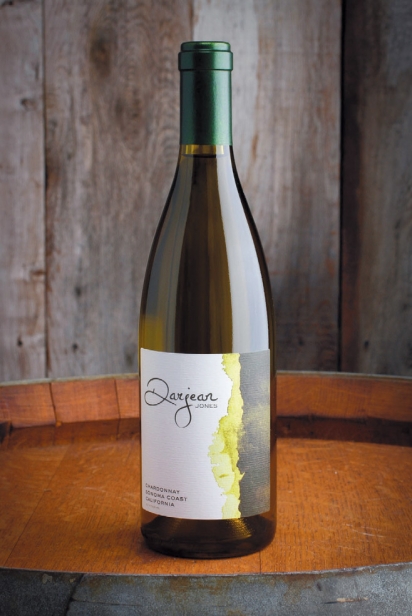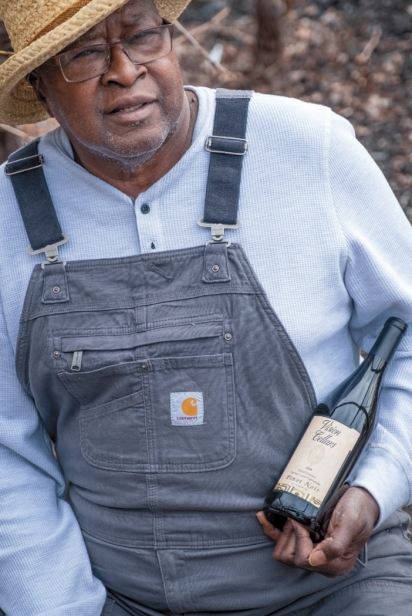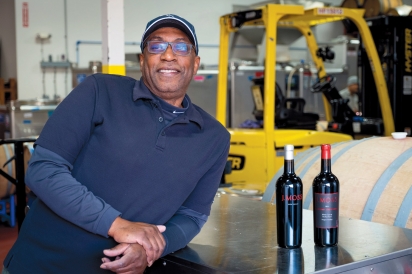Red, White & Black
AFRICAN AMERICAN REPRESENTATION IN THE WINE INDUSTRY REMAINS SMALL, BUT POTENT
When Mac McDonald, a first-generation vintner, released his first wine in 1996, he placed a West African tribal mask on the label. Oh, did Mac— who I believe to be California’s first African American winemaker—take guff. He says that he was told by sales types that because of that mask, they could never sell his wine—that the “scary” visage had to go. When McDonald tried to sell his wine in Japan, he was met with similar resistance. As a rejoinder he told them, “Toyota doesn’t ask me to approve their label.”
Heading into his 25th year as a vintner at his Sonoma County–based Vision Cellars, which produces about 2,400 cases annually of Pinot Noir, Edward “Mac” McDonald, now 77, finds himself the dean of what is a slowly growing but still woefully unrepresented niche of the California wine business: winery owners and winemakers who are black.
According to my research, there are around 35 African American– owned wineries or wine brands and businesses in the entire country, a preponderance of which are located in Sonoma and Napa counties. That is a tiny number, out of about 10,000 brick-and-mortar wineries or brands in the U.S.
According to Marcia Jones, the creator of Urban Connoisseurs, a wine consultancy and event planning business that works to provide scholarships to black students pursuing careers in the wine industry (and first reported by Grape Collective), there are only about 60 African American-owned or -run wine businesses on the planet.
On the consumer side, however, two annual events held here in the Bay Area attract large numbers of African American wine lovers: the Oakland Wine Festival and Black Vines. And although the numbers are still infinitesimal, Jermaine Stone on his podcast “Wine & Hip Hop,” recently said, as also reported by Grape Collective, “We’re experiencing an explosion, kind of like a black renaissance, in wine and culture.”
WHY SO FEW?
Dawna Darjean Jones, 43, first-generation owner and winemaker of Darjean Jones Wines, who since 2010 has been making about 250 cases annually of prominently sourced single-vineyard Merlot, Viognier, Cabernet Franc and Chardonnay in southern Napa, has observed that African Americans are “such a small environment” in the wine business “that we all know each other.”
Likely the first black winemaker in the Napa Valley, Jones adds, “I find it hard to believe that there are so few of us. … It’s a very difficult business to crack into when you’re not inheriting something; and starting at ground zero.”
James Moss, also the first in his family to get into the wine business, since 2000 has been producing wine under the J. Moss Wines label. He now makes about 1,400 cases of Cabernet Sauvignon, Merlot, Chardonnay and Petite Sirah in southern Napa. Moss, too, expressed consternation about breaking into what is such a tough business in which to gain a foothold—no matter who you are. But for African Americans, it’s even harder.
He says he started with only $5,000, and today, 20 years later, he’s incrementally rising into the pantheon of known Napa Valley winemakers. “People didn’t take me seriously at the beginning because I’m black. You’re getting over the stigma of just being African American. You have to change the mind-set of people.”
“Liquid to lips, one person at a time,” is his mantra.
“I don’t look at it as a white or black thing, I look at it as a person who had a passion, who fell in love with doing what they wanted to do,” Moss says. “I just happen to be black. I love the romance of it all. And I really thought I could be successful doing it.”
MAKING PROGRESS
“I’m glad black America is looking for me,” says Moss. “It’s about time. I truly believe it’s [ J. Moss Wines] getting recognized.” He then adds, “Some people want to be known as a black winemaker. I just want to be known as a winemaker who happens to be black. White winemakers don’t say ‘I’m a white winemaker.’ I don’t want to be put in that bubble.”
Jones concedes, “I don’t know if I’ve chosen an easy path in life. I’m an African American female winemaker and plant pathologist who studied wine grape diseases.” She is also the second black woman to earn a PhD in plant pathology from UC Davis. The first is Helene Dillard, who inspired her when she saw Dillard’s picture in the halls at Davis, and who is now the dean of the UC Davis College of Agricultural and Environmental Sciences. ‘If she can do it, I can do it,’” Jones says she told herself.
“I didn’t get into wine business thinking there weren’t any African American winemakers,” she exclaims. “But I was pretty amazed the [black] community was welcoming.” She then adds, “I can’t say I’ve had any issues at all in terms of the [predominantly white] winemaking community, but from a customer perspective I’ve gotten some sideways glances.”
Nonetheless, and as a kind of affirmation, Darjean Jones Wines made their screen debut in the 2018 Tyler Perry movie Nobody’s Fool.
Other notable members of this small but growing wine industry community include Brenae Royal, 29, manager of the historic 250-acre Monte Rosso Vineyard (now owned by Gallo) near Agua Caliente in Sonoma County, and Carlton McCoy Jr., 34, one of two current African American master sommeliers and the president and CEO of Napa Valley’s Heitz Cellars.
MENTORING THE NEXT GENERATION
As for Vision Cellars’ Mac McDonald, his approach to the black presence in the wine business is more pragmatic than social or political, more focused on the business aspect. To this end, he co-founded the Association of African American Vintners, which currently has around 10 members.
When asked what advice he’d give to an African American just entering the industry, he says simply, “Make the best wine you can make, and make wine that you want to make.
“When I look back to when I started, there wasn’t a great number of people who looked like me,” he relates. “I wanted to have a good wine and compete against the best of the best. It wasn’t an easy thing to get going, but it’s [the wine industry] not an easy thing for anybody no matter what color you are.”
McDonald also has some definitive ideas about how he’d like to be remembered. “My big goal in life is my obituary,” he says, noting that he wants it to read: “Who have I assisted in this world to make them a better life?”
“People tell me I’ve shown them the way. All that means a lot to me.”
As for that African mask, he says he did not put it on his labels to make a political statement, adding, “I’m not into that separation stuff. There’s enough separation in the world. It was just that I like African art; I wanted to do something that represents things that I like. I wanted to stand out and to have people discuss that art while they’re having dinner. I am big and bold in this business, but I’ve toned it down.”
The mask is not displayed as prominently as it once was on McDonald’s bottles these days. It’s what’s in the bottle, he intimates, that is always the only thing that should count.
And McDonald’s wines are counted—Vision Cellars’ wines have been served at the Clinton, Bush II and Obama White Houses.
DarjeanJonesWines









